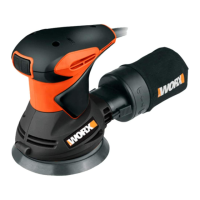Random orbital sander EN
10
OPERATION INSTRUCTIONS
NOTE: Before using the tool, read the
instruction book carefully.
INTENDED USE
The machine is intended for dry sanding of
wood, plastic, metal and filler material as well
as painted surfaces.
Machines with electronic control are also
suitable for polishing.
The sander is not to be used for plastering.
1. CHANGING HOOK & LOOP
SANDPAPER (See Fig. A, B)
The Sanding Paper (7) and sanding plate are
provided with a hook and loop attachment
system to allow quick and easy changing
of the sanding and polishing accessories.
Firstly, remove any dust or other objects from
the hook and loop on the sanding plate and
Sanding Paper. As the Sanding Paper has dust
extraction holes you must align these with the
holes in the sanding plate, otherwise the dust
extraction will not function. (See Fig. A)
To remove the Sanding Paper, lift one corner
of the paper and pull off from the sanding
plate. (See Fig. B)
2. DUST BAG (See Fig. C1, C2, D)
— ATTACHING THE DUST BAG (See Fig.
C1)
Always operate your sander with the Dust Bag
(3) fitted.
To attach, slide the bag onto the outlet piece
and take care that the Latching Lever (5)
engages.
CAUTION!
To prevent the possibility of sanding
dust or foreign body being thrown in to your
face or eyes, never attempt to use your sander
without the dust bag properly installed.
— EMPTY THE DUST BAG (See Fig. C1,
C2, D)
For more efficient operation, empty the Dust
Bag (3) every 5-10mins. This will permit the air
to flow through the bag better.
Method 1: To empty the Dust Bag, press the
Latching Lever (5) in and pull off the bag from
the dust extraction port, and shake out dust.
(See Fig. C1, C2)
Method 2: To empty the bag, rotate the bag to
the unlock position. Remove the bag and shake
out dust. (See Fig.D)
3. OPERATING THE ON/OFF SWITCH
(See Fig. E)
To start your sander, depress the protective
cover over the switch at the position marked “I”.
To stop your sander, depress the protective
cover at the position marked “0”.
4. HAND GRIP AREA (See Fig. F, G)
Your sander is designed to be held either
around the main housings, or by the top of the
main housing. When sanding for long periods
at a time, it is recommended you periodically
alternate between the two holding positions.
5. SANDING SURFACES
Place the machine with the complete Sanding
Paper (7) on the surface to be worked. Ensure
uniform sanding pressure. Less sanding
pressure increases the sanding capacity and
protects the machine and the sanding tool.
The removal capacity and the sanding pattern
are determined mainly by the selection of the
Sanding Paper (grain size), the speed of the
sanding plate and the application pressure.
ROUGH SANDING
Attach a Sanding Paper (7) with coarse grain.
Apply only light sanding pressure to achieve
increased material removal.
FINE SANDING
Attach a Sanding Paper (7) with fine grain. With
moderate pressure, move the machine in a
circular pattern or alternately in lengthwise and
crosswise directions over the workpiece. Do not
tilt the machine to avoid sanding through the
work piece (e.g. when sanding veneer). After
finishing the work, switch off the machine and
lift it from the workpiece.
6. ORBITAL SANDING
Guide your sander parallel to the working
surface and move it in circles or in a cross
pattern. Do not tilt the tool in order to avoid
deep unwanted sanding marks. The amount of
material removed is determined by the speed
of the sanding disc and the grit size used. The

